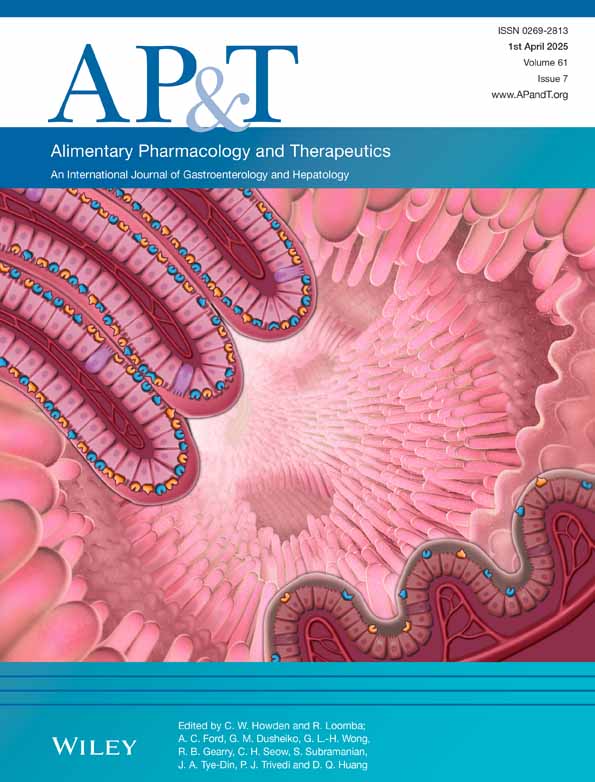Editorial: Linking Overt Hepatic Encephalopathy Post-TIPS to Mortality!
Funding: The authors received no specific funding for this work.
Transjugular intrahepatic portosystemic shunt (TIPS) placement is an effective therapy for portal hypertension-related complications and has significant survival benefits for patients with recurrent/refractory ascites and variceal bleeding [1]. Although procedure-related mortality is low (< 1%), common post-TIPS complications, which affect quality of life, include overt hepatic encephalopathy (OHE), decrease in liver function and cardiopulmonary dysfunction [2]. Around 30%–50% of patients develop an episode of HE post-TIPS, with 10% developing disabling HE requiring recurrent hospitalisations [3, 4]. However, the impact of post-TIPS OHE on mortality remains unclear.
Xiang et al. conducted a large multicentre retrospective cohort study comprising 3262 patients with cirrhosis underwent TIPS for variceal bleeding [5]. Post-TIPS OHE occurred in 33.2% of patients, of which 631 (19.3%) patients subsequently died. It was found that post-TIPS OHE independently predicted long-term mortality (beyond 24 months), but not short-term mortality within 6 months. Additionally, development of post-TIPS OHE within 1 month was associated with higher long-term mortality. The authors must be lauded for this exceptional long-term follow-up study, which provides invaluable insights into HE and mortality.
A recent multicentre prospective study by Nardelli et al. reported that episodic post-TIPS OHE was not associated with higher mortality [6]. However, the percentage of patients with persistent post-TIPS OHE was significantly higher among patients who died. It is worth noting that median follow-up in this study was 30 months, slightly less than the 1077 days (~35 months) in Yi's study. A subsequent meta-analysis of seven cohort studies comprising 1712 patients showed that post-TIPS HE was associated with increased risk of mortality [7]. Yi's observation is hence in line with current literature, and the large cohort size adds credence to the link between post-TIPS HE and mortality. Additionally, Hartl et al. supported the observation that early onset of post-TIPS OHE within 1 month was linked with higher mortality [8].
Short-term mortality post-TIPS is predominantly driven by liver function, portal hypertension and stent-related complications, thereby suggesting a lack of association between post-TIPS OHE and short-term mortality. Only history of ascites and diameter of TIPS stent were significantly associated with mortality at 6 months, which suggests that these patients had an existing significant degree of portal hypertension not fully correctable by TIPS. Furthermore, 43.4% of patients who died within 12 months had stent dysfunction, which may exacerbate portal hypertension-related complications.
The study has numerous limitations. First, a higher proportion of patients with OHE had variceal bleeding, which may have been the trigger for HE and mortality. The study did not report the severity scores, cardiopulmonary complications and prophylactic measures at various post-procedure time points, which could have been invaluable in identifying predictors of HE and mortality [9]. In addition, sarcopenia is a key factor, which could affect post-TIPS mortality, and was not accounted for in this study [10]. More granular data on post-TIPS OHE (time to development of HE, classification and severity) and association of these parameters with mortality will refine our understanding of the impact of post-TIPS OHE on mortality. Further studies are needed to assess the impact of prophylactic therapies in prevention of HE and develop biomarkers for prediction of HE pre-TIPS. (Table 1).
| Before TIPS | After TIPS |
|---|---|
| True indication and selection of patient are essential for elective TIPS | Educate about signs and symptoms of HE to patient and caregivers and need for follow-up |
| Age: Preferably less than 65 years | Monitor signs of MHE, psychometric tests (?) |
|
Hepatic reserve: Removal/control of triggers (especially toxin/hepatotropic viruses /drugs) Identifying minimal HE Prefer—MELD ≤ 15, Child–Pugh score ≤ 10 Continue anti HE measures if past history of HE |
Avoiding triggers—drugs/toxins, dehydration Continuation of antiviral management to prevent the progression of disease Titrating disaccharidase solutions Prophylactic rifaximin/LOLA (?) |
| Recognition of sarcopenia and its treatment |
Aggressive nutritional management to improve sarcopenia No protein restriction |
| Using 8-mm dialable stents to achieve recommended PPG of 8–23 mmHg |
Regular screening for stent functioning Diameter reduction/stent closure LT in case of refractory complications |
| Role of corrected sodium in patients with hyponatremia (?) | Role of beta blockers for prevention of bleed related HE (?) |
- Abbreviations: LOLA, L-ornithine L-aspartate; LT, liver transplant; MELD, model for end-stage liver disease; MHE, minimal hepatic encephalopathy; TIPS, transjugular intrahepatic portosystemic shunt.
Author Contributions
Anjan Kumar: writing – original draft. Margaret L. P. Teng: writing – original draft. Anand V. Kulkarni: conceptualization, writing – review and editing.
Conflicts of Interest
The authors declare no conflicts of interest.
Linked Content
This article is linked to Xiang et al paper. To view this article, visit https://doi.org/10.1111/apt.18509
Open Research
Data Availability Statement
The authors have nothing to report.




